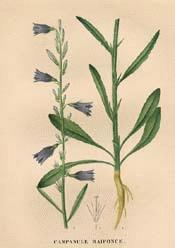
Botanical.com Home Page

|
Rampion
(Campanula rapunculus LINN.)
Click on graphic for larger image
|
Rampion
Botanical: Campanula rapunculus (LINN.)
Family: N.O. Campanulaceae
---Synonym---Ramps.
---Part Used---Herb.
---Habitat---The plant is found wild in England, on gravelly roadsides and hedgebanks and in open pastures, from Stafford southwards, but it is uncertain whether it should be held as a true native in the localities in southern England, where it is now established.
The Rampion formerly regularly cultivated in English kitchen gardens, and much valued as a wholesome esculent vegetable, is seldom grown for use now, though its graceful flowers are sometimes seen to advantage in the borders as an ornamental plant.
The name Rampion is derived from its Latin specific name, Rapunculus, a diminutive of rapa (a turnip). It is still much cultivated in France, Germany and Italy, and occasionally here, for the roots which are boiled tender like parsnips and eaten hot with a sauce. They are sweetish, with a slight pungency, but though wholesome, are considered inferior to other roots now more widely grown for culinary use. The larger roots are reserved for boiling, sometimes the young roots are eaten raw with vinegar and pepper, and occasionally the leaves, as well as the roots, are eaten as a winter salad. The leaves can be used in the summer and autumn as a substitute for spinach. The young shoots may be blanched like asparagus and prepared in the same manner.
---Description---The roots are fleshy and biennial (but can be made perennial), the stems are 2 to 3 feet high, erect, stiff, though rather slender, generally simple, more or less covered with stiff, white hairs, which almost disappear when cultivated. The leaves are variable, 1 to 3 inches long, the radical leaves oblong or ovate, on long stalks and slightly crenate, the stem-leaves narrow and mostly entire, or obscurely toothed. The flowers, which bloom in July and August, are about 3/4 inch long, reddish purple, blue or white, on short peduncles, forming long, simple or slightly branched panicles. The corolla is divided to about the middle into five lanceolate segments. The capsule is short and erect, opening in small lateral clefts, close under the narrow linear segments of the calyx.
Drayton names it among the vegetables and pot-herbs of the kitchen garden, in his poem Polyolbion, and there is a reference to it in the slang of Falstaff, showing how generally it was in cultivation in this country in Shakespeare's time.
There is an Italian tradition that the possession of a rampion excites quarrels among children. The plant figures in one of Grimm's tales, the heroine, Rapunzel, being named after it, and the whole plot is woven around the theft of rampions from a magician's garden. In an old Calabrian tale, a maiden, uprooting a rampion in a field, discovers a staircase that leads to a palace far down in the depths of the earth.
[Top]
---Cultivation---Rampion is easily cultivated and will flourish in ordinary good soil, though a moist, sandy soil suits it best.
Seeds should be sown in shallow drills, a foot apart, in May, and thinned out to 5 or 6 inches in the rows. The young plants should be moderately watered at first.
If grown for culinary use, it must not be allowed to flower, and the roots should be earthed up several inches on each side in order to blanch them. They are fit for use in November, and should be lifted then and stored in a frost-proof place.
---Medicinal Action and Uses---Gerard tells us: 'Some affirme that the decoction of the roots are good for all inflammation of the mouth and almonds of the throte and other diseases happening in the mouth and throte, as the other Throte warts.'
An old writer states that the distilled water of the whole plant is excellent for the complexion and 'maketh the face very splendent.'
---Other Species---
Two other native species have been employed dietetically, Campanula rapunculoides and C. persicifolia, but they have fallen into disuse as culinary vegetables, though the latter is a favourite in the flower border.
All the plants of the genus have a milky juice, which is more or less acrid, though not sufficiently so to act poisonously.
[Top]
Common Name Index
A MODERN HERBAL Home Page
Bear in mind "A Modern Herbal" was written with the conventional wisdom of the early 1900's. This should be taken into account as some of the information may now be considered inaccurate, or not in accordance with modern medicine.
© Copyright Protected 1995-2024 Botanical.com
|

